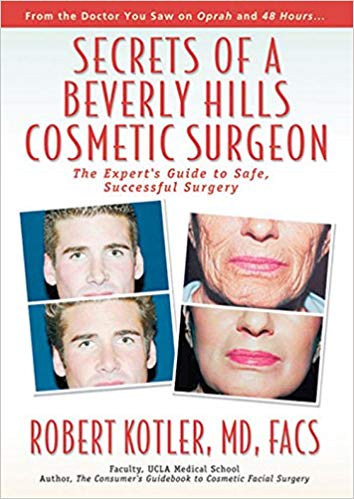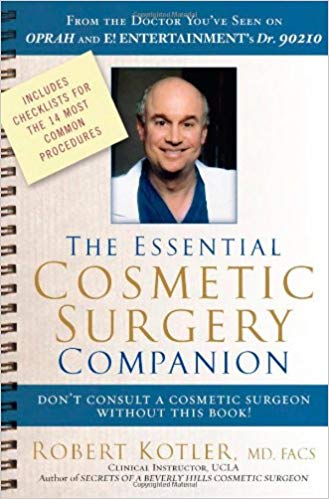Get Your Free Copy Today!
Secrets of a Beverly Hills Cosmetic Surgeon
 Now, from the world’s beauty capital, Beverly Hills, comes an eye-opening exposé of American cosmetic surgery. An increasingly popular but sometimes controversial young specialty.
SECRETS OF A BEVERLY HILLS COSMETIC SURGEON is the definitive, insider’s guide to choosing a top specialist, selecting the right procedure and using a safe facility all at an affordable price.
Dr. Kotler, one of America’s premier cosmetic surgeons and a prominent UCLA teacher, lecturer and author draws upon his unique 40 years experience and more than 10,000 procedures performed. No co-writer, no ghostwriter required. Because the inner workings of this highly-hyped but little-explained field are best revealed by only those who live within it.
Now, from the world’s beauty capital, Beverly Hills, comes an eye-opening exposé of American cosmetic surgery. An increasingly popular but sometimes controversial young specialty.
SECRETS OF A BEVERLY HILLS COSMETIC SURGEON is the definitive, insider’s guide to choosing a top specialist, selecting the right procedure and using a safe facility all at an affordable price.
Dr. Kotler, one of America’s premier cosmetic surgeons and a prominent UCLA teacher, lecturer and author draws upon his unique 40 years experience and more than 10,000 procedures performed. No co-writer, no ghostwriter required. Because the inner workings of this highly-hyped but little-explained field are best revealed by only those who live within it. - Why do some celebrities look so bad after cosmetic surgery? What’s wrong with this picture? There are 3 reasons; not just bad luck. And there are lessons here for non-celebrities, too.
- Fees are negotiable without compromising quality. You just have to know the ropes. Dr. Kotler lists 5 strategies to save dollars.
- Because of managed care, doctors are fleeing their practices and flooding into cosmetic surgery. Gynecologists, general surgeons, even some dentists! But re-training is inadequate, inconsistent; not all are qualified. How can you determine who is competent and who is not?
- Prospective patients rarely learn about superspecialists, the doctors at the pinnacle. Trained beyond board certification to earn the skills you want.
- Not all training programs are turning out qualified cosmetic surgeons. Because of economic pressure, overcrowded teaching hospitals now have tiny budgets and little space for cosmetic surgery teaching cases. And if there are few patients on which to practice, how do the young doctors get good enough to operate on you?
- Consultation should not be a high-pressure sales session. Is that free consultation good for the patient or the practice? To be in charge, you must know the important questions to ask. Dr. Kotler lists the 15 Smart Questions to ask the doctor as you interview him.
- You must see many photographically-honest “before and after” images. The doctor’s work, not purchased from a stock album. How else can you know if the doctor produces natural results that would satisfy you? Because you don’t want to see windblown, over-pulled face lifts, too-scooped, too-pinched nose jobs or fake-looking breast implants.
- The surgical facility is just as important as the surgeon. How do you know if the facility is judged safe? Did it pass inspection? Who are the inspectors?
- Not quite ready for the bigger procedures? Want to hear the low-down about less-invasive procedures and skin treatments like intense pulse light? Dr. Kotler explains the accomplishments and limitations of the 24 most popular.
- Certain prescription, non-prescription and herbal/homeopathic medications can cause serious surgical or anesthesia complications. Like ginko, ginseng or even garlic. Appendix D lists 136 such products!
The Essential Cosmetic Surgery Companion
 This step-by-step workbook features:
This step-by-step workbook features:
- A 5-minute Telephone Screening Script to use when speaking with a surgeon’s office manager before committing to a time-consuming and costly consultation.
- Checklists for the 14 Most Popular Procedures, including rhinoplasty, breast augmentation and liposuction.
- The 29 Most Important Questions to Ask at the Consultation as well as a Consultation Summary Form for each practice.
- A 37- Question Quiz to rate and compare each cosmetic surgery practice (including anesthesia and surgical facilities).
- A Cost Tabulation Worksheet.
For starters, the prospective patient is often confused by just discerning who is, and who is not, qualified to perform cosmetic surgery. There is no American Board of Medical Specialties certification in cosmetic surgery as there is for 24 other recognized specialties. How, then, does one differentiate the “cosmetic surgeon” from the “plastic surgeon,” the “ophthalmic plastic surgeon,” the “dermatologic plastic surgeon” and the “facial plastic surgeon?”
Procedure selection is even more complicated because each surgeon is an artist; no two perform an identical procedure. The terminology is inconsistent, confusing. What is the difference between a “Cheek lift,” a “Mid-face lift,” a “Mini-lift,” the “S-lift” and the brand new “Threadlift?” Regarding wrinkle erasure, is a chemical peel superior to a laser peel? And which chemical peel: Phenol? TCA (tri-chloroacetic acid)? Glycolic acid? Should a nose job be performed “open”, utilizing a visible, external incision or “closed” through hidden, internal incisions?
Good preparation means knowing which questions to ask. And, then, remembering to ask them. One patient related she was so flustered by an intimidating and haughty surgeon, she forgot what she wanted to ask. One of many good reasons for a patient to have the questions in hand, in an organized format.
I have learned from patients in my 28 years in private practice. And after listening to patients bemoan the challenges of knowing which questions to ask at the consultation, I realized I could impart my knowledge and offer a valuable learning resource in a unique and practical format. A consultation workbook that supplies the essential questions you must ask the doctor during your consultation. The closest thing to my sitting beside the patient at the consultation and coaching them on what to ask the doctor.
This step-by-step workbook includes custom Checklists for the 14 Most Common Procedures, a 5-minute Telephone Screening-Script to sort out a practice mis-match before committing to a time-consuming and costly consultation and a 37-Question Quiz to objectively “score” each practice visited. The higher the score, the more likely the patient will have found the practice right for him or her. The book also includes A Cost Tabulation Worksheet, Anatomical Sketches for the doctor to illustrate his game plan and a Directory of Companies that Finance Cosmetic Surgery.

